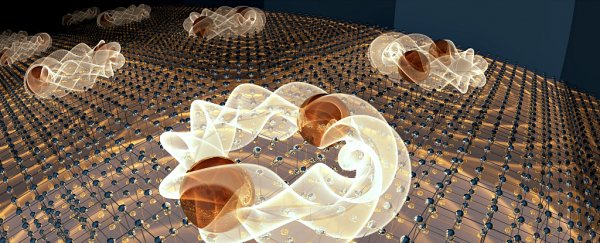One of the ultimate goals of modern physics is to unlock the power of superconductivity, where electricity flows with zero resistance at room temperature.
Progress has been slow, but in 2018, physicists have made an unexpected breakthrough. They discovered a superconductor that works in a way no one's ever seen before - and it opens the door to a whole world of possibilities not considered until now.
In other words, they identified a brand new type of superconductivity.
Why does that matter? Well, when electricity normally flows through a material - for example, the way it travels through wires in the wall when we switch on a light - it's fast, but surprisingly ineffective.
Electricity is carried by electrons, which bump into atoms in the material along the way, losing some of their energy each time they have one of these collisions. Known as resistance, it's the reason why electricity grids lose up to 7 percent of their electricity.
But when some materials are chilled to ridiculously cold temperatures, something else happens - the electrons pair up, and begin to flow orderly without resistance.
This is known as superconductivity, and it has incredible potential to revolutionise our world, making our electronics unimaginably more efficient.
The good news is we've found the phenomenon in many materials so far. In fact, superconductivity is already used to create the strong magnetic fields in MRI machines and maglev trains.
The bad news is that it currently requires expensive and bulky equipment to keep the superconductors cold enough to achieve this phenomenon - so it remains impractical for broader use.
But in 2018, researchers led by the University of Maryland observed a new type of superconductivity when probing an exotic material at super cool temperatures.
Not only did this type of superconductivity appear in an unexpected material, the phenomenon actually seemed to rely on electron interactions that are profoundly different from the pairings we've seen to date. And that means we have no idea what kind of potential it might have.
To understand the difference, you need to know that the way electrons interact is dictated by a quantum property called spin.
In regular superconductors, electrons carry a spin referred to as 1/2.
But in this particular material, known as YPtBi, the team found that something else was going on - the electrons appear to have a spin of 3/2.
"No one had really thought that this was possible in solid materials," explained physicist and senior author Johnpierre Paglione.
"High-spin states in individual atoms are possible but once you put the atoms together in a solid, these states usually break apart and you end up with spin one-half. "
YPtBi was first discovered to be a superconductor a couple of years ago, and that in itself was a surprise, because the material doesn't actually fit one of the main criteria - being a relatively good conductor, with a lot of mobile electrons, at normal temperatures.
According to conventional theory, YPtBi would need about a thousand times more mobile electrons in order to become superconducting at temperatures below 0.8 Kelvin.
But when researchers cooled the material down, they saw superconductivity happening anyway.
To figure out what was going on, the 2018 study looked at the way the material interacted with magnetic fields to get a sense of exactly what was going on inside.
Usually as a material undergoes the transition to a superconductor, it will try to expel any added magnetic field from its surface - but a magnetic field can still enter near, before quickly decaying away. How far they penetrate depends on the nature of the electron pairing happening within.
The team used copper coils to detect changes in YPtBi's magnetic properties as they changed its temperature.
What they found was odd - as the material warmed up from absolute zero, the amount that a magnetic field could penetrate the material increased linearly instead of exponentially, which is what is normally seen with superconductors.
After running a series of measurements and calculations, the researched concluded that the best explanation for what was going on was that the electrons must have been disguised as particles with higher spin - something that wasn't even considered as a possibility for a superconductor before.
While this new type of superconductivity still requires incredibly cold temperatures for now, the discovery gives the entire field a whole new direction.
"We used to be confined to pairing with spin one-half particles," said lead author Hyunsoo Kim.
"But if we start considering higher spin, then the landscape of this superconducting research expands and just gets more interesting."
This is incredibly early days, and there's still a lot we have to learn about exactly what's going on here.
But the fact that we have a brand new type of superconductivity to test and measure, adding a cool new breakthrough to the 100 years of this type of research, is pretty exciting.
"When you have this high-spin pairing, what's the glue that holds these pairs together?" said Paglione.
"There are some ideas of what might be happening, but fundamental questions remain-which makes it even more fascinating."
The research was published in Science Advances.
A version of this story was first published in April 2018.
